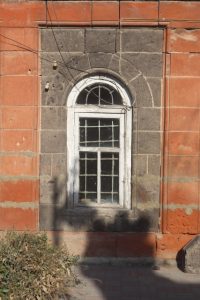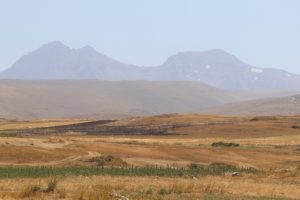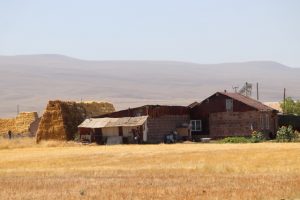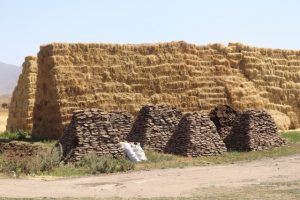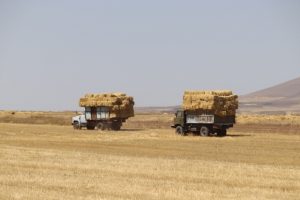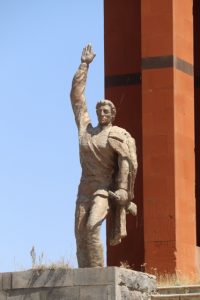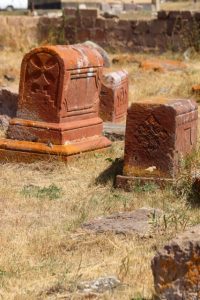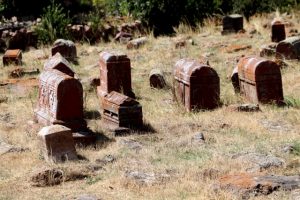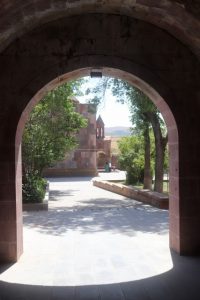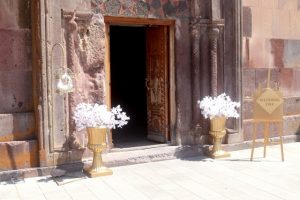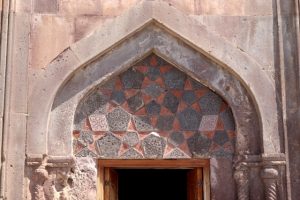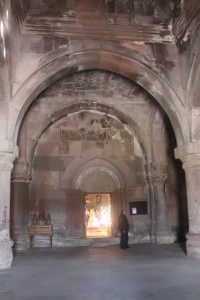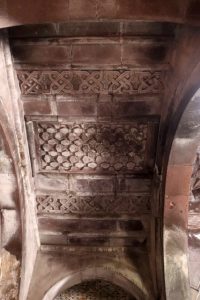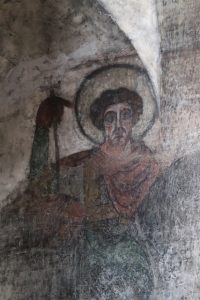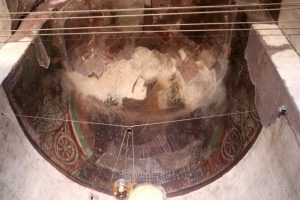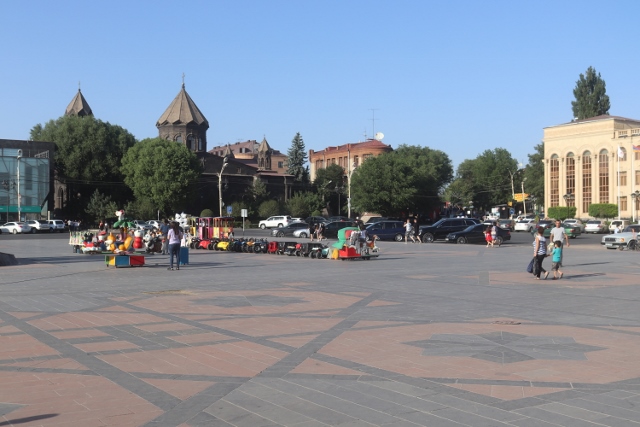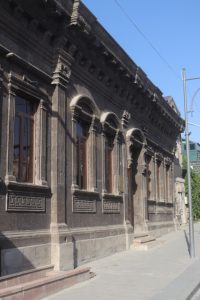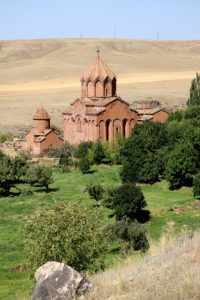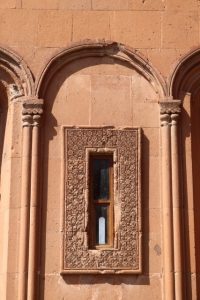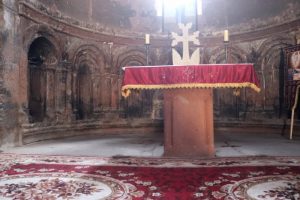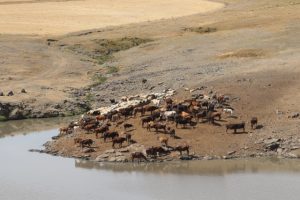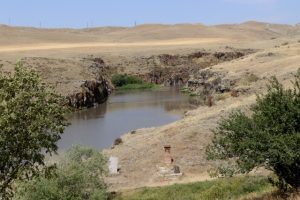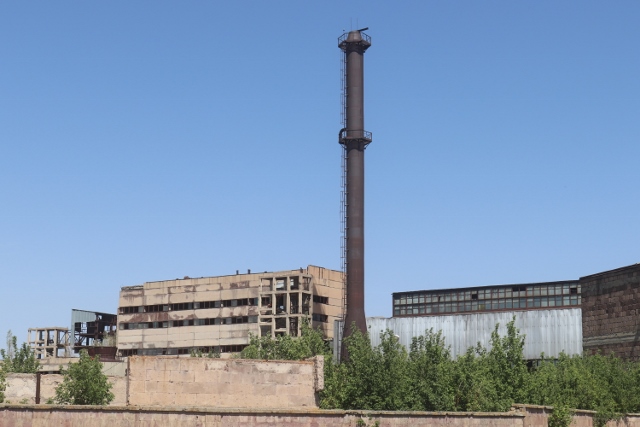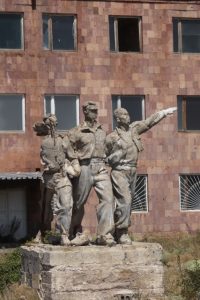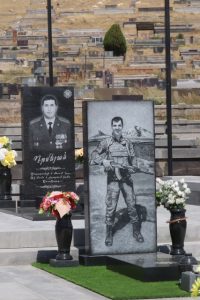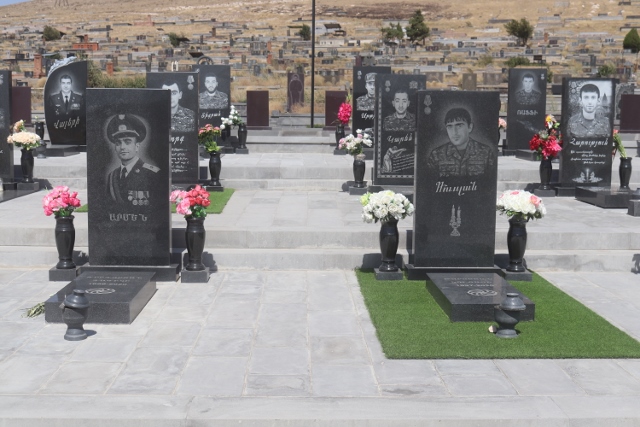More churches and monasteries on the road to Gyumbri, which is an unexpectedly nice town.
Our road to Gyumri rounds the slopes of Aragats, Armenia’s highest mountain, counter-clockwise. The mountain itself is, in fact, not that spectacular, a few peaks on top of a plateau, and so here and there what looks like patches of snow. More impressive is the landscape, the desolate plains, burnt yellow; hardly any other vegetation than the grass that is being harvested as fodder for the animals in the winter. Stacked next to the dung of those same animals, that will be used as fuel in the winter. The few people who live here are clutching together in small villages, it is not like Georgia, scattered houses everywhere. You expect poverty, yet, the villages we pass consist mostly of good, stone houses.
In the middle of nowhere we come across a memorial, with a sculpture of a soldier. No further indication as for what it commemorates, the memorial itself fenced off. Along the road in the next village, Norashen, is an impressive cemetery, with what looks really old tombs – although I cannot read any of what is written.
Nearer Gyumri we find the large Harichavank Monastery, like the ones around Ashtarak part 7th Century – the small Saint Gregory’s Church -, part 13th Century – the much bigger Mother of God Church. In between, a large, vaulted gavit shows interesting, almost oriental patterns in the roof, whilst the door to the gavit, with its red and black stone mosaic, would not be misplaced in a mosque. The monastery is popular with weddings, today – a peculiar thing is, that, although the weddings last quite a while, everybody seems to be too late, thus must drive their car as fast as possible to a place as close as possible to the church. We had already identified that it would be wise to park our own car as far from the church as possible, and indeed, the chaos nearer was complete when a second wedding arrived before the first one had been concluded.
The nicest church is in fact the tiny one of Lmbatavank, on a low hill outside the village. You’d almost expect the church to be closed, but no, a Russian lady caretaker welcomes us, and explains – in Russian – about the healing properties of the church as long as you genuinely pray. Outside are the tombs of those who, presumably, didn’t prey enough, inside we admire the few remaining frescos and carved stone decorations.
Gyumri itself is the second-largest city in Armenia, but certainly it doesn’t have that feeling: the centre seems really small, traffic is slow because people drive slowly, not because it is busy. You wouldn’t immediately recognise it today, but Gyumri was one of the towns worst affected by the 1988 earthquake, the last major earthquake that seriously shook Armenia. It levelled the town of Spitak, 30 km away and the epicentre, whilst it also destroyed 60-80% of Gyumri’s buildings, killed at least 25,000 people, and made 500,000 homeless. Much has been rebuilt since, initially thanks to an impressive Soviet response, although there are still places that have not been restored. Interestingly, the older buildings, from Tsarist times, seem to have been better resistant to the quake damage than Soviet constructions. In parts of the town, these Tsarist structures have been revived, and form an unexpected, but attractive bonus to Gyumri – which, incidentally, was renamed Alexandropol in 1837, after the wife of Tsar Nicholas who visited the town, only to be renamed Leninaken in 1924, after the death of Lenin. Anyhow, now it’s Gyumri again.
There is little to do in town. But there is a pleasant atmosphere, unhurried, unpretentious, unglamourous, in every aspect counter to what Yerevan is. And it still has its café culture!
On the north side of Gyumri is another must-visit monastery, Marmashen. This one, mostly 10th Century, is unique in that, where most monasteries have been built high up in the mountains, with commanding views, Marmashen is in a river valley, the Akhurian River, close to the water. The complex consists of several churches, not all of which have survived. As with many other monasteries and churches, there are extensive decorations, carvings around the entrances and the windows, and niches inside. Outside the church are several ancient Khachkars, marking graves. But, admittedly, we are starting to feel a bit of an overkill, with all those churches. And we have only just started!
Next: more monasteries along the Debed Gorge
Luckily, we also encounter construction of another type, or what is left of the construction. On the way to the NE of the country, we came across – finally – some old, decrepit Soviet factory, the type we have seen in so many ex-Soviet republics, and also in Eastern Europe. I find these buildings fascinating – even though, in this case, I don’t even know what the factory was for.
Like I find cemeteries fascinating: the one along the road is largely dedicated to military personnel who have died, quite recently, so to see. Victims of the senseless war with Azerbaijan, I presume. National heroes, nonetheless, depicted on their gravestones in uniform.
Admittedly, my travel companion is less charmed. It is hot outside, very hot, and the countryside hasn’t changed much, is still hilly, dry and yellow. Which after a while, also becomes monotonous.
